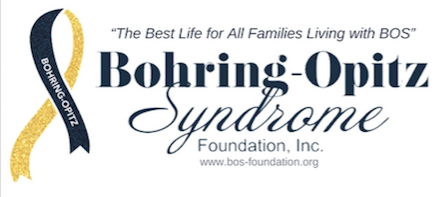Family Finding Answers After 57 Year Search for a Diagnosis
Carl and Ann hold magazine with Jill and Vaughan's story
When Jill Morris agreed to be featured in an article about living with Bohring-Opitz Syndrome (BOS), along with her son Vaughan who is diagnosed with the rare condition, she had no idea the impact it would have on another local family in her hometown of Warrenton, Virginia.
Jill had recently returned from Rare Disease Week in Washington, DC so awareness of BOS was fresh on her mind. She was thrilled when Warrenton Lifestyle Magazine wanted to feature her journey raising a child with a syndrome so rare it is estimated there are only about 80 people in the world diagnosed at this time.
“I always wanted to share my personal story in hopes of helping others. I just felt this need to write what I did because maybe there was a family who didn't have a diagnosis yet; that was still frantically seeking an answer like I had,” Jill explained.
After the article was published, a couple also from Warrenton, connected with Jill through the magazine saying they suspected their son might have the rare syndrome, only 57 years earlier. The odds that another family in the same town had a child with BOS almost seemed impossible to Jill.
“I never could have imagined this happening,” Morris said, “I was nervous and excited at the same time because of the possibility,”
Carl and Ann’s Story
Their son Gregory was born August 13, 1960 at Arlington Hospital in Virginia. At birth, Gregory had a large birthmark in the center of his forehead, a partial cleft palate, abundance of hair, and his hands were turned downward. His respiratory system was very weak and he appeared to lack muscles in his neck, which had to be supported. All of these are symptoms of BOS which wasn’t discovered until 2011.
“We had excellent doctors, especially our Pediatrician Dr. Robert Hunt, but they were all confused and no one had any answers,” noted Ann.
Gregory was seen twice at the National Institutes of Health (NIH), sometime in the 1962-1964 time frame. Again, no answers were found as to what may have caused Gregory’s condition.
Life went on for Gregory and his family despite not having an answer. It took a year, but he was able to eat by mouth. His food had to be pureed so it wouldn’t come through his cleft palate. Although he never spoke, he was able to make sounds.
In 1971, at age 10, Gregory passed away from pneumonia. In November of 1994, the couple moved to Warrenton, VA and had Gregory moved to the Warrenton Cemetery in October of 1997 to be closer to them.
“He was a special child who is missed by our family so much,” Ann said.
Possible Answers
In May of 2017, Ann came across the article about Jill and Vaughan where she recognized similarities to her son. She showed it to her husband and children and they all agreed it sounded like Gregory.
Soon after contacting Jill, the couple opened their home to her, sharing pictures and stories of Gregory. Jill agreed that Gregory most likely had BOS and shared their story with Taylor Gurganus of the BOS Foundation, with the family’s permission.
“The courage it took to reach out to me and to take a chance is commendable itself. I feel honored that they shared their son's life with me,” said Jill.
Taylor took the information and pictures to Dr. Tan and Dr. Vergano, two of the Foundation’s Medical Advisory Board Members, on behalf of Gregory’s family. With everyone agreeing on the theory Gregory might have had the syndrome, Dr. Tan suggested that if the family had any hair or teeth from Gregory they could perform testing to see if it revealed a definitive diagnosis of BOS to solve the 57-year-old mystery.
Continued Connections
Taylor and her family also went to visit the couple and shared their stories with one another. She explained that a DNA test might offer answers they had been searching decades for. After the couple spoke with Dr. Tan, they are hoping to work together to find some answers.
“Research can take a while, but regardless of the outcome, they are now a part of the BOS family,” said Taylor.
This unexpected connection has surprised everyone involved and shown the importance of awareness about Bohring-Opitz Syndrome. It has also forged bonds and friendships none of these families could have ever dreamed of. Ann and Carl still stay in touch with both Jill and Taylor.
Jill still can’t believe the unfolding of this family’s story and how her article helped bring some peace of mind to another family.
“The love we have for our children brought us together and has made us stronger. It's truly an experience I will never forget,” Jill continued, “The family feels I have given them a gift, but honestly they are a gift to me.”
Bohring-Opitz syndrome is a rare genetic condition characterized by intrauterine growth restriction (IUGR), failure to thrive, sleep apnea, developmental delay, hypotonia, flexion of the elbows and wrists, excessive hair growth, Wilm's tumor, microcephaly, brain malformations, and distinctive facial features. The condition is caused by mutations in the ASXL1 gene. (1)(2) The inheritance of Bohring-Opitz syndrome remains unknown, as nearly all cases to date have occurred sporadically. [3] Last updated: Apr 12, 2016 (credits: National Institutes of Health (NIH) Brief Explanation )




